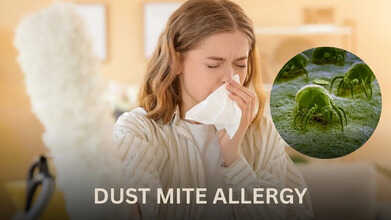- Health Conditions A-Z
- Health & Wellness
- Nutrition
- Fitness
- Health News
- Ayurveda
- Videos
- Medicine A-Z
- Parenting
- Web Stories
Study Suggests Six Personality Traits That Make Us 'Cool' – Is It Genetic Or Acquired?

(Credit-Canva)
Ever wondered what makes someone "cool"? A new international study published in the Journal of Experimental Psychology suggests that no matter where you live, "cool" people often act in similar ways.
Researchers from universities in Chile, the United States, and other countries found that people considered "cool" share six key personality traits. These traits were consistent across all 12 countries included in the study, which surveyed nearly 6,000 people from 2018 to 2022. Countries included Australia, Chile, China, Germany, India, Mexico, Nigeria, South Africa, South Korea, Spain, Turkey, and the United States.
Six Common Traits of "Cool" People
These traits were found to be consistent regardless of a person's age, gender, or education level. The study, identified the following traits in people seen as cool:
- Extroverted
- Pleasure-seekers (hedonistic)
- Powerful
- Adventurous
- Open to new experiences
- Independent
Coolness vs. Goodness
Interestingly, being a "good" person was linked to different traits, such as being calm, kind, warm, traditional, and secure. People who were seen as capable often had qualities that made them seem both cool and good.
Also Read: First UK Adult To Receive Treatment For Type 1 Diabetes Drug Undergoing Trials
Researchers explained that these "cool" traits are likely part of someone's core personality and aren't easily taught. Another lead researcher noted that while cool people are usually somewhat likable, their traits don't always mean they are morally "good," especially when considering being hedonistic and powerful.
Deeper Meaning of "Cool"
Reviewing the study's findings, researchers noted that "coolness" can have both positive and negative meanings in real life. They suggested that future research could explore the differences between "good coolness" and "bad coolness."
Researchers also pointed out that their study only included people who already understood the term "cool." It's not clear if people in very traditional or isolated cultures would view the same traits as admirable.
They emphasized that "cool" is a deeply embedded part of our social language. It acts as a quick way to understand someone's status, connections, and identity, especially in today's social media and influencer culture. Understanding "coolness" helps us see how quick judgments about traits influence behavior and social interactions.
Many of these personality traits have also been found to be genetic, so the question arises, are we born with these traits?
Is Human Personality Genetic?
In a 2020 study published in the Genes, Brain, and Behavior journal, researchers explained that our personality traits are simply the lasting ways we tend to think, feel, and act in different situations. Studies of twins and families show that our personality traits are partly inherited from our parents.
Also Read: Aspirin Isn’t Always Safe For Older Adults Anymore—Here's Why Doctors Are Warning Against It
This means our genes play a role in shaping who we become. These traits can even give clues about future mental health conditions. What these genetic studies of personality have shown is that personality, like many brain-related diseases, is influenced by many genes working together (this is called being polygenic).
Five-Personality Traits That Are Connected To Genes
Researchers at Yale School of Medicine (YSM) published a study in 2024 Nature Human Behavior where they found several DNA spots linked to specific personality traits. Researchers used information from a large program called the Million Veteran Program. They looked at people's genes to find tiny differences, called "loci," that are connected to the "Big Five" personality traits
Extraversion: How outgoing you are.
Openness: How open you are to new experiences.
Agreeableness: How well you get along with others.
Neuroticism: How prone you are to negative feelings like worry or sadness.
Conscientiousness: How organized and disciplined you are.
The "Big Five" traits are a common way scientists measure personality. In this study, participants answered questions about their personality and also gave a blood sample for genetic testing.
By comparing their answers to their DNA, the team found 62 new genetic spots linked to neuroticism. They also found genetic spots for agreeableness for the very first time. When they combined all their results, they identified over 200 genetic spots across all five personality traits.
The team also looked at the genetic connections between personality traits and various mental health conditions. They found a strong overlap between neuroticism (a personality trait with a lot of negative feelings) and depression and anxiety.
On the other hand, people who scored high in agreeableness (meaning they tend to get along well with others) were less likely to experience these conditions. These links were already known, but this study provides new genetic proof.
With each research on such topics, we come one step forward to finding better answers and treatments for mental health conditions.
What Is A Polygenic Score And How It Could Reveal Your Future Breast Cancer Risk?

Credits: Canva
Breast cancer is the most frequently diagnosed cancer in women, accounting for over 15% of all new cancer cases in the United States. Abnormal cell growth in the breast ducts (DCIS) or lobules (LCIS) can sometimes progress to breast cancer, but currently, doctors cannot predict which cases will develop into invasive cancer.
A recent retrospective study using the 313-SNP breast cancer polygenic risk score (PRS313) blood test suggests that women with abnormal cells are more likely to be diagnosed with breast cancer later on. This discovery could help identify patients who would benefit from targeted interventions while reducing unnecessary treatments.
Although DCIS and LCIS can progress to breast cancer, predicting which cases will remain harmless has been a challenge. However, this new study indicates that calculating a polygenic score may help forecast a future breast cancer diagnosis.
“It is therefore very important that we find ways to predict which women with DCIS and LCIS are most likely to develop invasive breast cancer in the future so they can be given the most appropriate treatment and avoid unnecessary treatment,” explained study senior author Elinor J. Sawyer of King’s College London (UK).
What Is A Polygenic Score?
A polygenic score is a numerical estimate of a person’s genetic likelihood of developing a particular trait or disease. When used to predict disease risk, it is often called a polygenic risk score (PRS), according to Harvard Medicine Magazine.
Sawyer and study lead author Jasmine Timbres (King’s College London) focused on PRS313, a blood test that evaluates breast cancer risk by identifying which of 313 specific genetic variations (single nucleotide polymorphisms, or SNPs) a person carries. The researchers examined PRS313 scores from more than 2,000 DCIS and LCIS cases across the ICICLE and GLACIER studies.
Their findings showed that, for DCIS, women with higher PRS313 scores were 2.03 times more likely to develop cancer in the opposite breast compared to those in the lowest score quartile. For LCIS, women with elevated PRS313 scores were 2.16 times more likely to develop cancer in the same breast. The risk was even higher for patients with a family history of breast cancer.
“LCIS is not always treated with surgery or hormone therapy because it is considered lower risk than DCIS. However, these results suggest that women with a family history may benefit from additional interventions to reduce their risk of developing cancer,” Timbres added.
How To Measure A Polygenic Score?
A polygenic score is calculated by looking at an individual’s genetic variations (like SNPs) and summing them with weights based on how strongly each variant is associated with a trait or disease, as determined by large-scale genome-wide association studies (GWAS). Researchers first identify genetic variants linked to a disease by comparing the genomes of people with and without the condition. Each variant’s effect size is then applied to the individual’s genome to create a single score representing their overall genetic risk.
Polygenic scores can be measured in research settings using GWAS data. They are also available through commercial direct-to-consumer genetic testing services or via clinical assessments provided by medical institutions and genetic counselors.
Limitations Of The Study
While these findings are promising, further research is needed to confirm results in other patient groups and to examine additional genetic factors. Some limitations include the fact that PRS313 was designed specifically to assess risk for invasive breast cancer, meaning it may not capture other relevant genetic changes in in-situ breast disease. Additionally, the number of women with LCIS in the study was relatively small, which may have limited the ability to detect statistically significant associations.
Do Green Crackers Really Make A Difference When It Comes To Pollution And Respiratory Health?

Credits: Canva
Days before Diwali celebrations took off, the national capital of India, Delhi has already logged 211 in the Air Quality Index (AQI), categorizing the quality as ‘Poor’. The Central Air Quality Management (CAQM), as a result, imposed Stage 1 measures under the Graded Response Action Plan (GRAP) across Delhi-NCR, which will ensure dust control measures, including the use of anti-smog guns around the construction and demolition sites and areas with higher AQI.
As Delhi prepares itself for Diwali, this year, the Supreme Court of India allowed the sale and bursting of green firecrackers in the city, after lifting last year’s blanket ban on all crackers.
The Supreme Court permitted the sale between October 18 and 21 and limited the timings to 6-7am and 8-10pm.The Chief Justice of India Bhushan R Gavai said, “We have to take a balanced approach permitting it in moderation while not compromising with the environment.”
However, what one needs to understand is whether green crackers really work for the environment.
Are Green Crackers Also Health Threats?
While it is true that green crackers are designed to cut emissions of particulate matter and harmful gases by 30 to 40% and keep the noise levels below 120 decibels, a joint study by Delhi Technological University (DTU) and IIT Roorkee shows that even green crackers release large volumes of ultrafine particles. These particles are smaller than 100 nanometers and can penetrate deep into the lungs.
Dr Rajeev Kumar Mishra, who is the senior researcher at DTU as reported by The Indian Express, said that more research must be done to assess atmospheric emissions of green crackers and their health impacts.
These small particles present in the green crackers can also become a hinder for people with existing pulmonary and respiratory issues, asthma, COPD, and heart problems.
Green crackers also emit fine and ultrafine particles like PM2.5 and PM1, and they are tiny enough to go deep in the lungs and even enter the blood streams. These tiny particles also contain small amounts of metals and chemicals which can cause breathing problems or worsen the issues in people with existing breathing problems.
Many experts also note that green crackers, while producing less sound, still exceed safe auditory limits. It can also cause relentless or disturbed sleep.
What Are The Health Risks?
As per the World Health Organization (WHO), air pollution can lead to stroke, ischaemic heart disease, CPOD, lung cancer, pneumonia, and cataracts.
Dr Sanjay Jain, a Delhi-based ENT and a member of DocTube also noted an increase in the number of patients with respiratory issues. "I have seen a notable increase in patients with upper respiratory tract infections, chronic sinusitis, and allergic rhinitis, which are directly linked to rising pollution levels," he says. From his experience, he has noticed a rough increase of 30 to 40% of patients with pollution-related ENT issues.
Dr Jain says that prolonged exposure to pollution can cause chronic ear infections in children due to inflammation in the Eustachian tube. "This is not commonly recognized by people," he says.
The act of burning firecrackers emits harmful and toxic gases such as carbon monoxide, which facilitate air pollution. This can cause health problems including skin irritation, respiratory issues, cancer, and asthma.
Deep Cleaning On Diwali Can Lead To Dust Mite Allergy; Here's How To Stay Safe

Credits: Canva
When Diwali comes near, every Indian household gets into full cleaning mode. The week leading up to the festival is usually spent sweeping, scrubbing, and dusting every corner of the home. While this ritual is believed to invite prosperity, it can also have some hidden problem, dust mite allergy.
If you start sneezing uncontrollably, coughing, or notice a runny nose while cleaning, chances are you are reacting to dust mites. But how serious can this allergy get? Let’s understand.
What Is Dust Mite Allergy?
Dust mite allergy, also called house dust allergy, happens when your immune system becomes sensitive to the droppings and remains of microscopic dust mites. These tiny, spider-like organisms live in bedding, mattresses, carpets, curtains, and furniture, feeding on dead skin cells shed by humans and pets.
According to the Cleveland Clinic, dust mite waste and dead bodies contain certain proteins that act as allergens. While these proteins are harmless to most people, some immune systems mistake them for dangerous invaders and trigger allergic reactions such as sneezing, asthma, itching, or eczema.
Can Dust Mite Allergy Trigger More Chronic Diseases?
Yes, a dust mite allergy can worsen over time and contribute to chronic conditions. The National Institutes of Health states that long-term exposure can lead to diseases like asthma and chronic sinusitis due to persistent inflammation.
Here are some chronic diseases linked to dust mite allergy:
- Asthma: Dust mite allergens are one of the main causes of asthma and can provoke severe attacks. Ongoing inflammation may make the airways overly sensitive and lead to permanent changes in lung tissue.
- Chronic sinusitis: Continuous exposure can inflame and swell the nasal passages, resulting in long-term sinus blockage and infections.
- Atopic dermatitis (Eczema): Though not a chronic disease itself, eczema can be made worse by dust mites, causing persistent irritation.
Why it can lead to chronic disease:
- Chronic inflammation: The immune system’s response to dust mites inflames the nasal passages and lungs. Prolonged exposure keeps this inflammation active, gradually damaging tissues.
- Increased sensitivity: Constant inflammation heightens sensitivity to smoke, pollution, or dry air, making symptoms more intense.
- The “atopic march”: This term describes the way allergic conditions can evolve, for example, eczema in childhood developing into asthma or allergic rhinitis later, often linked to dust mite sensitivity.
How Can Dust Mite Allergy Affect Your Body?
When your body first encounters dust mite proteins, it creates antibodies known as immunoglobulin E (IgE) to attack what it perceives as harmful allergens. On later exposure, your immune system reacts more strongly, releasing chemicals that trigger symptoms such as sneezing, itching, or congestion.
How To Treat Dust Mite Allergy: How To Stay Safe
The most effective way to manage a dust mite allergy is by reducing your exposure to dust mites. While it is impossible to remove them completely, minimizing contact helps prevent severe reactions. If symptoms appear, consult a doctor for the right medication. Those with asthma, sinusitis, or other chronic respiratory issues should avoid heavy cleaning during Diwali.
Here are some common treatment options available to treat dust-mite allergy. However, please note that you should take these only under the guidance of a medical professional:
- Antihistamines: Help control sneezing, itching, and watery eyes.
- Nasal corticosteroid sprays: Reduce inflammation and ease congestion.
How To Manage Dust Mites While Cleaning For Diwali
A few steps can help control dust mites while keeping your home festive and clean:
- Use an air conditioner or dehumidifier to keep humidity in check.
- Install a high-efficiency particulate air (HEPA) filter.
- Choose washable decorations and clean them regularly.
- Dust using a damp or oiled cloth instead of a dry one.
- Vacuum frequently with a vacuum cleaner that has a HEPA filter.
- Declutter your space to reduce dust buildup.
- Wash curtains and clean upholstered furniture often.
- If possible, replace carpets with wood, tile, vinyl, or linoleum flooring.
© 2024 Bennett, Coleman & Company Limited

